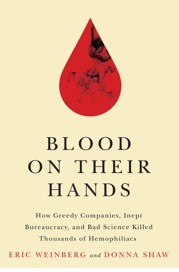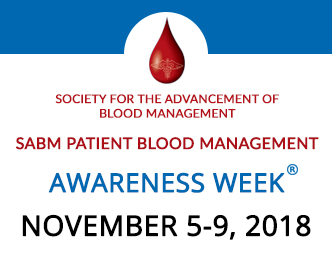JULY 2018
ISSUE

Please consider making a donation to your Society. Your donations will help us to improve the lives of people throughout the world through Patient Blood Management.
SABM 2018 Newsletter Publication Schedule
March | July | November
Carolyn Burns, MD
Editor
Tiffany Hall, RN
Associate Editor
Sherri Ozawa, RN
Kevin Wright
Contributors for This Issue
Nabil Hassan, MD
Stacey Valentine, MD
Brian Boville, MD
Susan Goobie, MD
Marketing & Membership Services
Carmen Melseth
SABM Officers and
Directors
|
Breaking Clinical News
Anemia in the Pediatric ICU
Anemia in Pediatrics is difficult to define. Comparisons to population norms is the principle in defining what is a normal hemoglobin (Hb) value. Normal Hb level and the cut off for anemia varies by age; however, several other variables may influence an observed subpopulation variability. Factors such as high altitude, race, diet, socioeconomic status, and prevalence of certain conditions, including parasitic or hemolytic diseases could all influence the average observed Hb in a given population.
It is not clear how acute illness influences the average patient’s Hb in the pediatric intensive care unit (PICU) patient. Demaret et al 1 have previously reported that in PICU patients, the proportion diagnosed with anemia varied by age; however, the median Hb did not. He concluded that the usual age-based definition of anemia may not be relevant for the critically ill children. I could not have agreed with him more. The absolute Hb level of a child influences oxygen delivery regardless of whether it crosses the anemia boundary or not. For example, a physiologic Hb of 9.5 gm in a critically ill infant may not be below the anemia threshold, but in the face of oxygen delivery constraints it may not be considered adequate or at least has no safety margin before reaching a critical level.
Recently, we have attempted to define the prevailing Hb level of patients in the PICU by conducting a point prevalence study in 59 PICUs in 8 countries 2. Data was collected on four specific days. An attempt was made to correlate the observed Hb with patient and PICU characteristics. The observed Hb did not show the known variations by age seen in normal population. Except in the neonates, all patients had very similar values. African-American patients had the lowest Hb along with Asian and Eskimo populations. Patients in Spain and Portugal had the highest observed Hb and highest incidence of transfusions compared to other populations. Complex heart disease, particularly cyanotic heart conditions, had the highest Hb reflecting a proactive pattern of keeping their Hb artificially at a very high level.
All significant variables were combined in a multivariate regression analysis. In children with cancer, none of the factors tested correlated with the observed patient Hb, suggesting other untested factors or an underlying practice pattern. Our work identified patient’s demographics that should be accounted for when investigating interventions across different patient populations. It also identified patients with cardiac disease and cancer as worthy of future blood conservation interventional studies.
Contributor: Nabil Hassan, MD
Medical Director of Pediatric Critical Care at OSF Healthcare Children's Hospital of Illinois
Chief, Pediatric Critical Care, and Visiting Professor of Clinical Pediatrics
Department of Pediatrics at University of Illinois, Peoria, IL
References
- 1 Demaret et al. Anemia a pediatric intensive care unit: prevalence and risk markers. Ann Intensive Care (2017) 7:107
- 2 Hassan et al. Hemoglobin levels across the pediatric critical care spectrum: a point prevalence study. Ped Crit Care Med 2018; 19: e227
|

Donna Shaw, co-author of Blood on Their Hands, is speaking on this fascinating subject at the SABM 2018 Annual Meeting.

The Society for the Advancement of Blood Management (SABM)
invites healthcare organizations worldwide to participate in this week dedicated to educating patients and healthcare professionals about patient blood management.
FOLLOW US ON INSTAGRAM

© 2018 Society for the Advancement of Blood Management
350 Engle Street Englewood, NJ 07631 USA Phone: (928) 551-6400 Fax: (877) 944-2272 EMAIL: [email protected] |